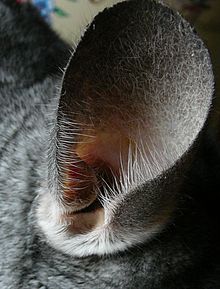Sensory Neuroscience: Hearing and speech/Outer & middle ear/auditory canal
The ear canal (aka external auditory canal) is lined with epithelial cells. Particularly in the outer , these cells secrete wax (cerumen).
Cerumen & cilia
[edit | edit source]
The cells lining the auditory canal have cilia (specialized hair) pointed out towards the pinna, which are extremely sensitive to tactile stimulation. Human ears have quite short hairs, but they serve the same purpose as those in the chinchilla pictured to the right. Try teasing a cat's hairs while they're sleeping and you're liable to lose a precious body part - the hairs are very sensitive, and for good reason: they guard against foreign bodies entering the ear.
Cerumen has some antibiotic and antifungal properties. The cells which form the lining of the canal begin their life at the centre of the eardrum (the umbo), and migrate out towards the pinna at about the same rate as the growth of your fingernails.
Modelling the auditory canal
[edit | edit source]The auditory canal is a tube with one end closed, so it is best suited to carrying some frequencies better than others:
(plus harmonics, which are natural multiples of this frequency)



